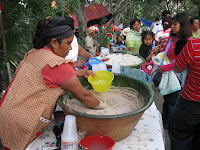Temazcal is another of those fabulous Aztec traditions of spiritual rejuvenation that has endured in the more indigenously-rich parts of Mexico. It involves ones marinating in an herbal steam bath heated by hot rocks to bring about the purification of the body and mind thr
 ough relaxation, perspiration, meditation, respiration and near expiration. In the Nahuatl (Aztec) language, ‘temaz’ means bath and ‘calli’, home. With your French friend (in my case, the lovely Florence) you embark on a journey approximately twenty minutes from the center of Oaxaca and with a knock on the door simply labeled ‘Las Bugambilias’, are admitted to a garden paradise and the ethereal world of your bath home. Mariana, hostess, master temazcalera and a woman so serene I half expected her to evaporate before my eyes in a quiet effusion of light, explains the temazcal process to you: where you are to strip down and wrap up in a sheet, where you get down on your hands and knees and climb through a doggy-door of sorts to enter the cube-shaped bath, dark and wooden, large enough for only three people and a pail of rose water . . . and how the cleansing process will essentially cure any problem you have ever had.
ough relaxation, perspiration, meditation, respiration and near expiration. In the Nahuatl (Aztec) language, ‘temaz’ means bath and ‘calli’, home. With your French friend (in my case, the lovely Florence) you embark on a journey approximately twenty minutes from the center of Oaxaca and with a knock on the door simply labeled ‘Las Bugambilias’, are admitted to a garden paradise and the ethereal world of your bath home. Mariana, hostess, master temazcalera and a woman so serene I half expected her to evaporate before my eyes in a quiet effusion of light, explains the temazcal process to you: where you are to strip down and wrap up in a sheet, where you get down on your hands and knees and climb through a doggy-door of sorts to enter the cube-shaped bath, dark and wooden, large enough for only three people and a pail of rose water . . . and how the cleansing process will essentially cure any problem you have ever had.Doing as we were told, Florence and I disrobed and crawled into the steam bath, which was heated to approxi
 mately four million degrees Fahrenheit. We then embarked on the first part of the process: seven minutes of meditation and perspiration. My knees didn’t really allow lotus-style sitting, so I tucked them up as meditatively as possible underneath me and tried not to think about my rapidly diminishing bank balance, my relatively imminent departure from Mexico, the exciting and crazy shenanigans of my family and friends, exactly how you conjugate caber in the third-person preterit tense, what sort of jazzy, life-changing job I was going to get once I returned home, the herd of goats that had passed by my apartment that morning, what was going to happen to Brisa, coveting Philbin Sunset and how I could really go for a bit more of that homemade granola from Cafe Brujula.
mately four million degrees Fahrenheit. We then embarked on the first part of the process: seven minutes of meditation and perspiration. My knees didn’t really allow lotus-style sitting, so I tucked them up as meditatively as possible underneath me and tried not to think about my rapidly diminishing bank balance, my relatively imminent departure from Mexico, the exciting and crazy shenanigans of my family and friends, exactly how you conjugate caber in the third-person preterit tense, what sort of jazzy, life-changing job I was going to get once I returned home, the herd of goats that had passed by my apartment that morning, what was going to happen to Brisa, coveting Philbin Sunset and how I could really go for a bit more of that homemade granola from Cafe Brujula.After this portion, we were joined by the temazcalera who began the more active part of the cleansing process. Dipping a bundle of herbs into the pail of water, she proceeded to beat Florence with it all over her body. Not exactly eager for my turn and trying not to giggle, I tried to focus on achieving a higher plane of being. Before I knew it, I was being slapped all over my body with a fresh, wet bundle of herbs. Rather than being painful, it was remarkably soothing. The chant-type melody being hummed by the woman as she covered me with the herbs combined with the ever-increasing temperature of the bath (or maybe the oxygen depletion?) did begin to alter my sense of being. By the time she had finished the first round of cleansing, I had lost all sense of time. The temazcalera threw the herbs onto the fire and the tiny room filled with a rich, enveloping woodsy smoke. As instructed, I breathed in deeply. The smell was intoxicating and though nearly as overwhelming as the heat, I couldn’t help but draw in more and more of the air, deeper and deeper each time. It was an incredible feeling—as if my lungs actually cooled with each, potently aromatic inhalation.
By the time the next cleansing process began, Florence and I had both lost our sheets and were completely soaked in sweat, but the fight to remain conscious overpowered my feelings of ridiculousness at being naked and drenched in a giant oven with two women, one of whom kept humming and whacking me with a shrub.
Finally, when I really was about to give way to a faint and Florence looked wrecked, but quite at ease in her semi-nudity as French girls can, we were doused in cool rose water and instructed to exit. We were given fresh sheets and shown to soft, plush, white beds surrounded by candles and allowed to nap a bit before our hour-long full body massage.
Later, sipping on enormous bottles of water, Florence and I exchanged a volley of “wows”, “no really, wow” as we headed back into the city. “You know, in Japan, I did something similar to this,” she reflected aloud. “At first I thought it was odd being naked in front of my friends, but in Japan, it’s quite normal.”
So, I guess my proviso warrants an addendum: when you take a Temazcal, be sure to do it with a French girl or a Japanese girl . . . or anyone with a healthy sense of humor who isn’t averse to a little chamomile action about his or her person.





